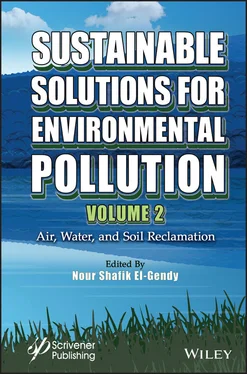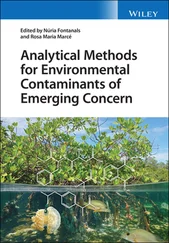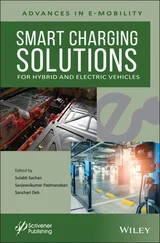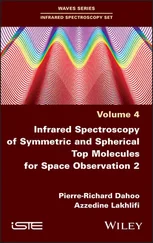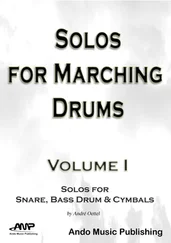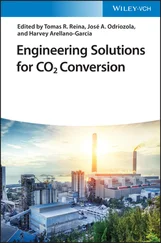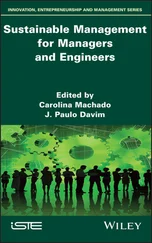Sustainable Solutions for Environmental Pollution, Volume 2
Здесь есть возможность читать онлайн «Sustainable Solutions for Environmental Pollution, Volume 2» — ознакомительный отрывок электронной книги совершенно бесплатно, а после прочтения отрывка купить полную версию. В некоторых случаях можно слушать аудио, скачать через торрент в формате fb2 и присутствует краткое содержание. Жанр: unrecognised, на английском языке. Описание произведения, (предисловие) а так же отзывы посетителей доступны на портале библиотеки ЛибКат.
- Название:Sustainable Solutions for Environmental Pollution, Volume 2
- Автор:
- Жанр:
- Год:неизвестен
- ISBN:нет данных
- Рейтинг книги:3 / 5. Голосов: 1
-
Избранное:Добавить в избранное
- Отзывы:
-
Ваша оценка:
- 60
- 1
- 2
- 3
- 4
- 5
Sustainable Solutions for Environmental Pollution, Volume 2: краткое содержание, описание и аннотация
Предлагаем к чтению аннотацию, описание, краткое содержание или предисловие (зависит от того, что написал сам автор книги «Sustainable Solutions for Environmental Pollution, Volume 2»). Если вы не нашли необходимую информацию о книге — напишите в комментариях, мы постараемся отыскать её.
This second volume in a broad, comprehensive two-volume set, “Sustainable Solutions for Environmental Pollution”, concentrates on air, water, and soil reclamation, some of the biggest challenges facing environmental engineers and scientists today.
AUDIENCE: Sustainable Solutions for Environmental Pollution,
Sustainable Solutions for Environmental Pollution, Volume 2 — читать онлайн ознакомительный отрывок
Ниже представлен текст книги, разбитый по страницам. Система сохранения места последней прочитанной страницы, позволяет с удобством читать онлайн бесплатно книгу «Sustainable Solutions for Environmental Pollution, Volume 2», без необходимости каждый раз заново искать на чём Вы остановились. Поставьте закладку, и сможете в любой момент перейти на страницу, на которой закончили чтение.
Интервал:
Закладка:
Plant uptake plays a dominant role in the elimination of clofibric acid and caffeine, and remains significant in the case of ibuprofen. Carbamazepine and MCPA (an herbicide) are relatively recalcitrant to all removal processes, although in hydroponic systems plant uptake accounts for half or more of the limited removal observed for these compounds (Zhang et al. , 2014a). Using of mutual beneficial combination of plants and bacteria can overcome this obstacle. Plant-microbe partnership with soft rush ( Juncus effuses ) and Indian shot ( Canna indica ) can eliminate more than 80% for certain macrolides (Tai et al. , 2017). Obviously, the elimination rates of biologically active molecules decrease as their concentration increases. Their concentration remain high, up to a concentration of a few µg/L. Microbes (rhizo- and endophytes) in this type of partnership not only directly degrade emerging pollutants but also accelerate plant growth by producing growth hormones and thus stimulate the bioremediation potential of CWs (Arslan et al. , 2017; Nguyen et al. , 2019a).
In a comparative study of the four major types of CWs, Ilyas and van Hullebusch (2020) noted better removal of 29 pharmaceuticals and 19 transformation products in hybrid systems, followed in descending order by VSSF-CWs, HSSF-CWs, and FSF-CWs. The coexistence of aerobic and anaerobic conditions and a longer HRT in hybrid CWs could explain the relatively good removal of diclofenac, acetaminophen, SMX, sulfapyridine, trimethoprim, and atenolol (Ilyas and van Hullebusch, 2020).
Treatment performances for pharmaceuticals are typically better in SSF-CWs, due to their large rhizospheric surface area, than in FSF-CWs (Zhang et al. , 2014a). However, obviously because of direct exposure to sunlight, pharmaceuticals sensitive to photo-degradation degrade more easily in FSF-CWs than in SSF-CWs (Ilyas and van Hullebusch, 2020). For some pharmaceuticals, such as diclofenac, ketoprofen (non-steroidal anti-inflammatories), and triclosan, photo-degradation seems the predominant route of elimination. Indeed, diclofenac, highly sensitive to photo-degradation, is more easily removed in FSF-CWs: 65%, than in SSFCWs: <45% (Zhang et al. , 2014a).
The bioconcentration factors are generally higher in the floating macrophyte species than in the submerged species. The more hydrophilic pharmaceuticals such as carbamazepine and diphenhydramine are more easily absorbed and transferred to leaf tissues (Pi et al. , 2017). VSSF-CWs seem more efficiently remove highly biodegradable pharmaceuticals, compared to HSSF-CWs, probably because they enhance aerobic microbial biodegradation due to a better oxygenation (Zhang et al. , 2014a). Xiong et al. (2018) summarize several novel approaches to the bioremediation of pharmaceuticals through the use of microalgae, including the construction of microbial consortia, acclimatization, and co-metabolism (Xiong et al. , 2018)
As in the case of nitrogen pollution removal, different types of CWs combined in hybrid systems, to exploit the specific advantages of each system and to provide aerobic and anaerobic conditions at the same time, are more effective. Highly biodegradable pharmaceuticals, such as ibuprofen, ketoprofen, and salicylic acid, show high abatement rates (87%, 99%, 81%, and 97%, respectively) in hybrid systems with a large redox gradient (Zhang et al. , 2014a).
CWs have real potential to reduce the fluxes of agricultural contaminants such as nitrates and pesticides. The implementation of green infrastructure undeniably contributes to reducing the transfer of contaminants in agricultural landscapes. Many pesticide retention processes (e.g., hydrolysis, photolysis, sedimentation, adsorption, biodegradation, or plant uptake) are involved in CWs, the intensity of which depends on local conditions and is attributed to the presence of vegetation. The highest removal rates were achieved for organochlorine, organosphorus and pyrethroid pesticides, while the lowest retention rates were observed for herbicides from the group of triazines and triazinones, aryloxyalkanoic acid, and urea. Pesticide removal is weakly correlated with the KOC value (Vymazal and Březinová, 2015). A reduction target of 50% can be expected by devoting only 1% of the upstream contributory area to a CW. Obviously, purification efficiency will vary greatly depending on the season, hydrological flows and the type of pollutants (Tournebize et al. , 2017). The degradation of pesticides involves two types of enzymatic reactions: lysis enzymes operating without any redox cofactor such as hydrolases and esterases; and oxidation and mineralization by redox enzymes such as oxidases, peroxidizes, and oxygenases (Gaur et al. , 2018). Lemna minor showed great potential to improve the water quality of textile effluents contaminated with Toluidine Blue dye (Neag et al. , 2018). Free floating macrophytes, viz ., Salvinia , Lemna , Eichornia , and Pistia showed their potential for the purification of waters containing perchlorate (Bhaskaran et al. , 2013).
1.10 Improving Bioremediation Systems
1.10.1 Introduction
As presented above, microorganism capacities to metabolize pollutants and convert them to non-toxic forms by redox reactions support the microbe-assisted or microbial bioremediation technologies. Some recent bibliographical reviews synthesize the knowledge acquired in microbial bioremediation with or without associated plants. Shahid et al. (2020) provide an in-depth insight into the specific role of microbes in bioremediation systems, specifically on rhizosphere-plant interactions in floating wetlands, but also relevant to CWs (Shahid et al. , 2020b).
Phytobiome around plant roots play a significant role in organic pollutant biodegradation during bioremediation process. The main ways of mobilizing phytobiome in bioremediation are as follows:
1 Bio-sorption is the passive adsorption of dissolved pollutants on the surface of living or dead cells. The pollutant changes phase but remains available in the environment. Bio-sorption can be a possible preliminary step to a proper biodegradation but it is not an actual removal from the environment. Adsorption intensity varies considerably depending on the hydrophobicity, structure, and functional groups of the pollutant involved. Pollutants with cationic groups are more effectively biosorbed on cell surfaces through electrostatic interactions. Biosorption is used as physical-chemical process, for metal removal (Verma et al., 2008; Fard et al., 2011; Ali et al., 2020);
2 Bio-accumulation is an active metabolic process requiring energy from the living organism to absorb and concentrate pollutants. Harvesting the organisms and exporting them out of the contaminated environment, allow removing the pollutants from the treated environment;
3 Biostimulation by nutrient input, air injection (bioventing), or by microbial fuel cell (inexhaustible TEA setup). Biostimulation consists in increasing the activity of endogenous microbes by feeding them with nutrients (e.g., organic carbon and nitrogen) or TEA (e.g., bioventing and bioelectro-remediation). The nutrient content stimulates the microbial co-metabolism of organic pollutants. Additionally some free radical-producing microbial oxidation-reduction enzymes will non-specifically oxidize the aromatic rings, open them and make them degradable by microbial enzymes. Obviously, biostimulation technologies involving discharge of wastewater in natural water systems should be avoided, and must be limited to stimulation without chemical inputs. Biostimulation is backed up by the phenomenon of co-metabolism, i.e., the simultaneous biodegradation of two organic compounds, in which the degradation of the pollutant depends on the presence of the microorganism’s normal carbon source. The additional carbon source serves not only to support biomass production, but also acts as an electron donor for the metabolism of the non-growthrelated pollutant (Xiong et al., 2018);
Читать дальшеИнтервал:
Закладка:
Похожие книги на «Sustainable Solutions for Environmental Pollution, Volume 2»
Представляем Вашему вниманию похожие книги на «Sustainable Solutions for Environmental Pollution, Volume 2» списком для выбора. Мы отобрали схожую по названию и смыслу литературу в надежде предоставить читателям больше вариантов отыскать новые, интересные, ещё непрочитанные произведения.
Обсуждение, отзывы о книге «Sustainable Solutions for Environmental Pollution, Volume 2» и просто собственные мнения читателей. Оставьте ваши комментарии, напишите, что Вы думаете о произведении, его смысле или главных героях. Укажите что конкретно понравилось, а что нет, и почему Вы так считаете.
